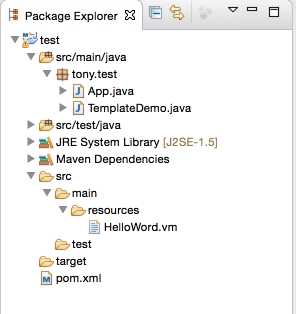标签:
Velocity 是一个基于 Java 的模板引擎。
本博文演示 Velocity 的 HelloWord 以及分支条件。
HelloWord.vm,模板文件。
templateDemo.java, 演示 Velocity 模板引擎。
App.java, 应用的入口
在 Eclipse 上,基于 maven 管理工具,运行后目录结构如下
源代码只存在于 ./src/main 目录下面。target 目录为 maven 生成输出的目录,可做参考。test 目录为测试代码目录,此处可忽略。
grs:test grs$ pwd
/Users/grs/Documents/Java/mavenDemo/test
grs:test grs$ tree
.
├── pom.xml
├── src
│ ├── main
│ │ ├── java
│ │ │ └── tony
│ │ │ └── test
│ │ │ ├── App.java
│ │ │ └── TemplateDemo.java
│ │ └── resources
│ │ └── HelloWord.vm
│ └── test
│ └── java
│ └── tony
│ └── test
│ └── AppTest.java
└── target
├── classes
│ ├── HelloWord.vm
│ └── tony
│ └── test
│ ├── App.class
│ └── TemplateDemo.class
└── test-classes
└── tony
└── test
└── AppTest.class
具体代码
HelloWord.vm,模板文件
Hello $name ! wwwwww
---
#if($value == 1)
value is 1, name is $name
#else
value is not 1, name is $name
#end
TemplateDemo,演示代码。需要注意的是,获取当前目录时,指向的是当前项目的根目录路径,所以在查找模板文件 HelloWord.vm 时,路径也是从项目根目录开始查找。
package tony.test; import java.io.File; import java.io.StringWriter; import org.apache.velocity.Template; import org.apache.velocity.VelocityContext; import org.apache.velocity.app.VelocityEngine; public class TemplateDemo { public static void main(){ File file = new File("."); System.out.println(file.getAbsolutePath()); try { VelocityEngine ve = new VelocityEngine(); ve.init(); Template template = ve.getTemplate("./src/main/resources/HelloWord.vm"); VelocityContext context = new VelocityContext(); context.put("name", "TTTTT"); context.put("value", "1"); StringWriter writer = new StringWriter(); template.merge(context, writer); System.out.println(writer.toString()); } catch (Exception e) { e.printStackTrace(); } } }
App 应用入口
package tony.test;
public class App
{
public static void main( String[] args )
{
TemplateDemo.main();
}
}
Eclipse 下的目录结构,以供参考

参考资料
Start up the Velocity Template Engine, javaWorld
Introduction to the Standard Directory Layout
标签:
原文地址:http://www.cnblogs.com/TonyYPZhang/p/5625458.html